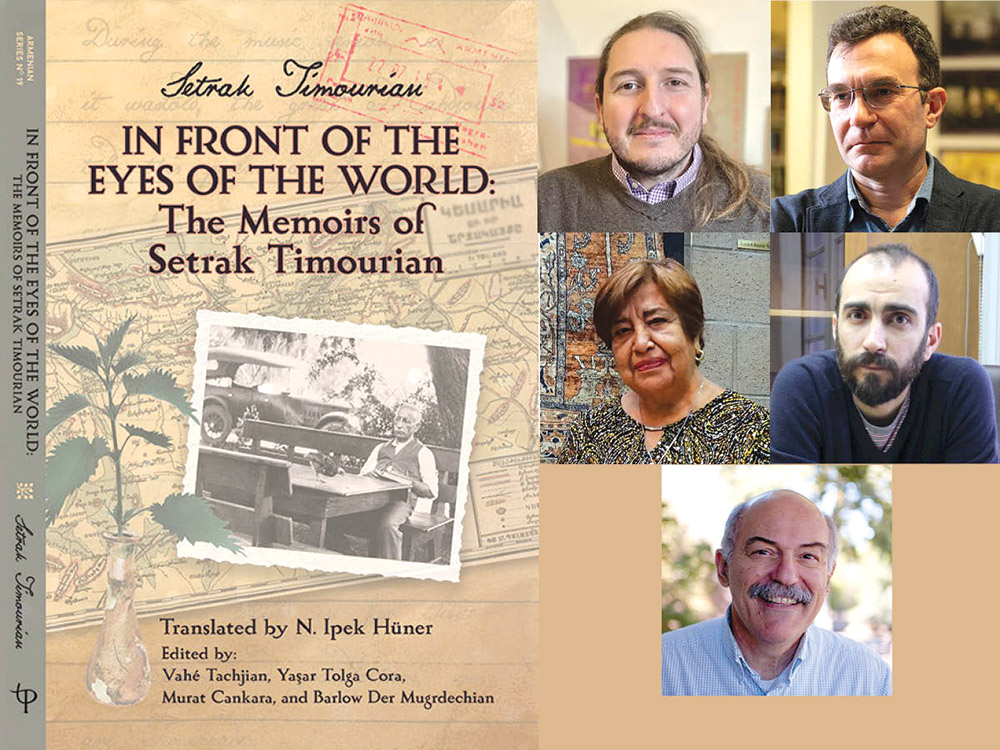
Ani Sargsyan
Staff Writer
“Every day I used to go and touch the memoir and say – when is your time going to come?” said Maggie Mangasarian-Goschen, director of Ararat Eskijian Museum, in reference to a visionary memoir by Setrak Timourian.
On Saturday, November 11, 2023, the Armenian Studies Program held a Zoom presentation on the publication of Timourian’s memoir, In Front of the Eyes of the World: The Memoirs of Setrak Timourian (Armenian Series number 18, The Press at California State University, Fresno: 2023). Guest panelists included editors Dr. Vahé Tachjian, Dr. Yaşar Tolga Cora, Dr. Murat Cankara, and Maggie Mangasarian-Goschen. Prof. Barlow Der Mugrdechian, a co-editor of the book, moderated the discussion.
“Setrak Timourian’s memoir is an important addition to the Fresno State Armenian Series,” said Prof. Der Mugrdechian. “It provides important insight about the life led by Armenians in the Ottoman Empire in the late nineteenth century.”
Goschen began by speaking about how her journey started in 2016 when she first received a call from Timourian’s granddaughter, Nazelie Elmassian, who wanted to donate some of her family heirlooms to the Museum. These family heirlooms marked the beginning of a journey in understanding the life of Setrak Timourian.
“When I visited Nazelie’s home, I felt I was in a time warp,” said Goschen. “I felt I was back in Kayseri, with all of the beautiful decorations and pictures.”
Goshen was given the manuscript and was asked to take it to the Museum, but always thought the memoir had more potential than to just be displayed. After meeting with scholars and getting the blessing of the family, this project began. On February 26-27, 2022, the Ararat Eskijian Museum and the Armenian Dress and Textile Project organized “1860 Gesaria (Kayseri) to Los Angeles 2022”: An International Conference and Exhibit, based on Timourian’s memoir.
The next speaker, Dr. Murat Cankara (University of Ankara), spoke about what the question of what is “Armeno-Turkish,” and the reasons it was so widespread in Ottoman Turkey. Armeno-Turkish is Turkish written in Armenian letters, and this is what Timourian used to pen his memoir. Dr. Cankara stated that some Turks would learn the Armenian alphabet to read texts written in Armeno-Turkish, as the Armenian letters accurately represented the sounds of Turkish.
The Armenian alphabet was used to write in Turkish for many reasons, one being that educational institutions used Armeno-Turkish to reach the local population. It was also a good way to express oneself in the written language because if you didn’t know Grabar (Classical Armenian), then Armeno-Turkish was the best way to express yourself in a written language.
The next panelist was Dr. Vahé Tachjian who spoke about the post-genocide period in the Armenian diaspora. Dr. Tachjian is director and chief editor of the Berlin-based Hushamadyan website. He spoke about the challenges faced by Genocide survivors in writing and publishing Armenian memoirs. Armeno-Turkish memoirs began to appear in various Armenian diasporic communities and these authors attempted to revitalize their history. One reason why memoirs were not more frequently published at the time was because of the lack of financial means, as most of the diasporan Armenians were refugees. Another reason was due to the domestic climate in the post-Genocide period. At the time the Armenian reviews and newspapers were only publishing memoirs by intellectuals, revolutionaries, clerics, politicians and not those of the common people. The Armenian community elite was restructuring and reinventing the Armenian culture and identity in a way that the Turkish language and Armeno-Turkish were excluded. Even with all these obstacles, Timourian’s memoir still found the light of day.
The final speaker was Dr. Yaşar Tolga Cora, an associate professor in the department of History at Boğaziçi University in Istanbul. Dr. Cora spoke on certain nuances that are hidden as the text has been translated from Armeno-Turkish to Latin script and edited. When they first started working, it was during the pandemic and they sat through Zoom meetings and shared the screen, working on the text line by line. The manuscript was deciphered, transliterated, and finally translated by N. Ipek Hüner.
Dr. Cora spoke about how Timourian’s choice in diction and language gave the work a unique flavor. Timourian would write certain words only in Armenian, in contrast to Armeno-Turkish, and these words related mostly to religion. Sometimes Armenian words were used with the Turkish equivalence in parenthesis, and some words were only in English (mainly of monetary value). The way that words were spelled also gave the editors knowledge on his education level, as there were some errors in spelling. Dr. Cora said it was important to pay attention to what Timourian wrote because it reflects his identity as an Armenian. Although a Turkish speaker, Timourian belonged to the Armenian community which was above all, religiously defined.
Setrak Timourian also had a San Joaquin Valley connection, as he spent his last years farming in the Fresno area, and is now buried in Fresno’s Ararat cemetery.
In Front of the Eyes of the World: The Memoirs of Setrak Timourian is available for purchase through Abril Books, http://www.abrilbooks.com/in-front-of-the-eyes-of-the-world.html or from the NAASR Bookstore, https://naasr.org/products/in-front-of-the-eyes-of-the-world-the-memoirs-of-setrak-timourian?_pos=1&_sid=b7f3b35ee&_ss=r, or on Amazon.
 Hye Sharzhoom Armenian Action
Hye Sharzhoom Armenian Action